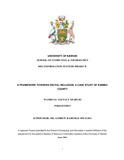| dc.description.abstract | The Internet as a global phenomenon has transformed the way people conduct business, interact, and learn on an international scale. Though more than half of the world’s inhabitants have access to ICT, the distribution of resources has not been uniform throughout the world. Digital divide is the gap between individuals, households, businesses and geographic areas at different socio-economic levels with regard both to their opportunities to access information and communication technologies and to their use of the Internet for a wide variety of activities. Internet access is a requisite for overcoming inequality in a society [where] dominant functions and social groups are increasingly organized around the Internet. Improved ICT access and use in Kenya rural areas can help to: Promote education through enhanced educational and teaching methods using e-learning approach; improve governance through involvement in policy-making; promote sanitation standards and increase health care provisions; promote E-farming where farmers access support and training on current and diverse farming trends using ICT and mobile platforms; help establish a global community where people can share ideas and opinions; promote local talents and job creation; help in attracting a wider range of investors and tourists and most important to the community, bring government services to the people. This study attempts to bridge digital divide by developing a framework for adoption to promote digital inclusion. To achieve this objective, the researcher adopted a descriptive survey that purposively targeted rural respondents to understand causes of digital divide. The researcher used questionnaires and document analysis guide as the main research instruments plus structured interview. The gathered data was then descriptively analyzed and presented in the form of frequencies, charts and graphs. This formed the basis for the discussion, findings and recommendations of the study. Data obtained was organized, coded and analyzed using qualitative and quantitative methods using SPSS (Version 20). The research findings suggest that whereas the digital gap on material access is closing in the region under study, the gap on access to skills, usage and utilization is still wide and requires intervention. The proposed framework for adoption indicates that government and infrastructure, human capital development and social perspectives are the main dimensions that weigh heavily on digital inclusion. | en_US |



